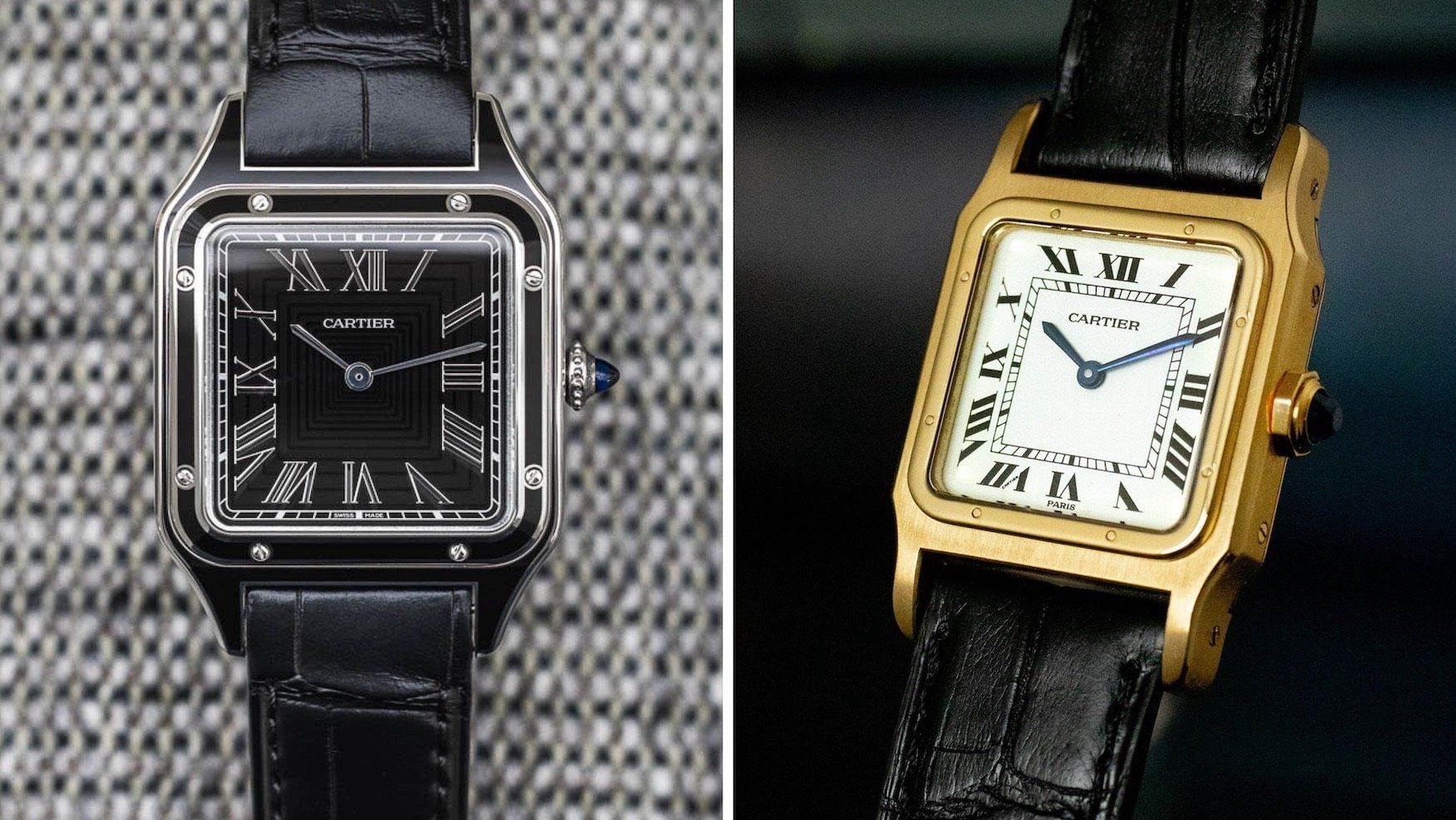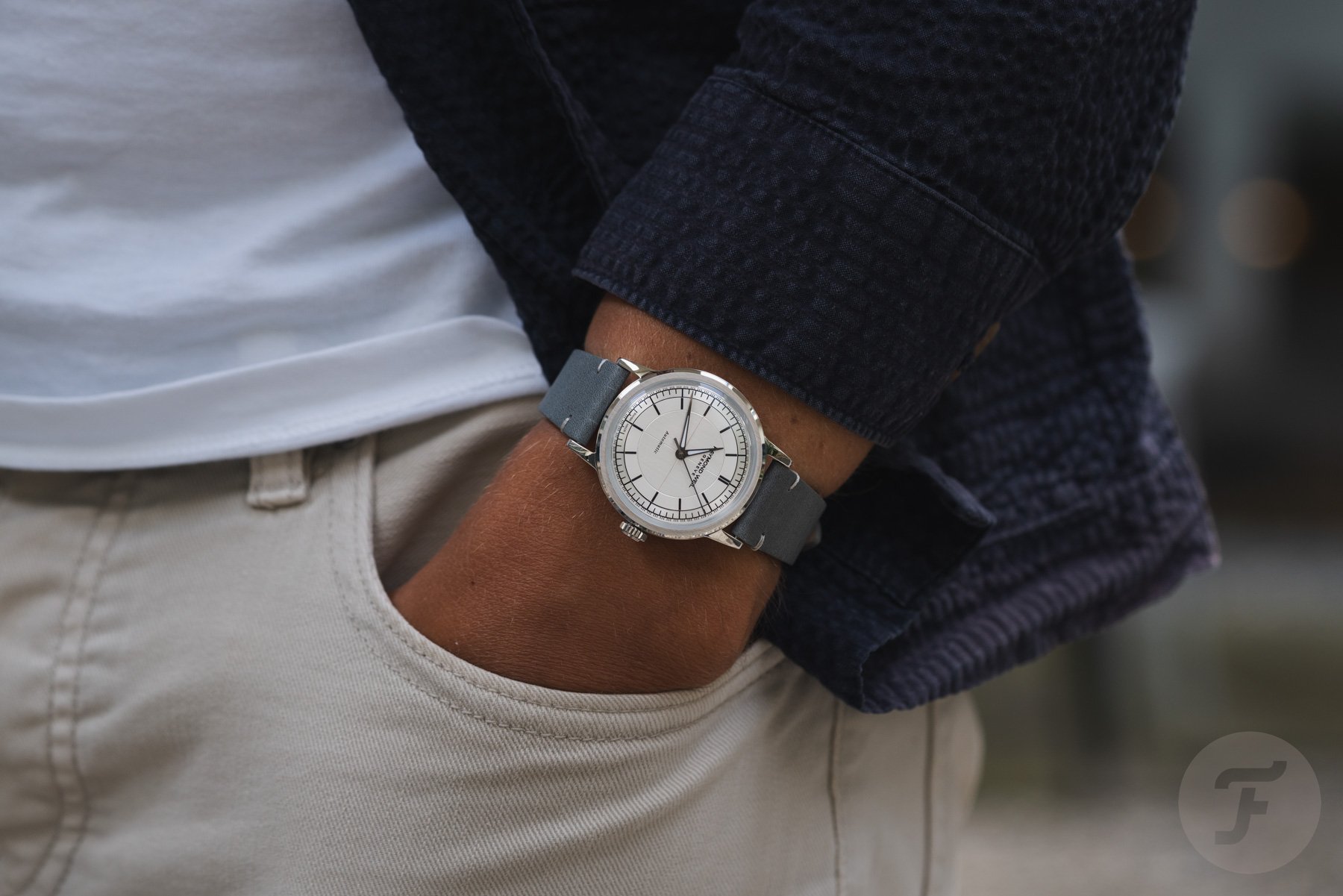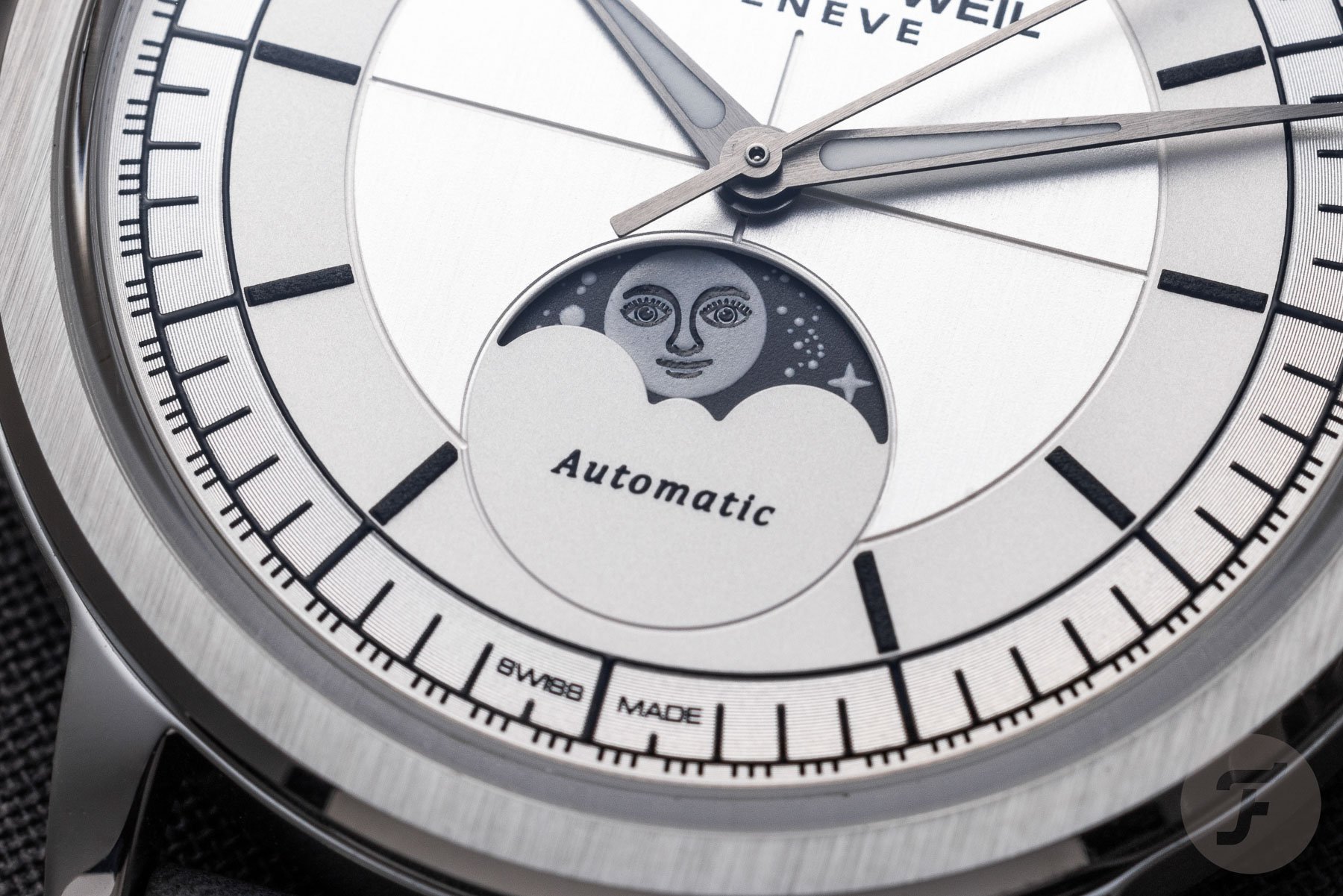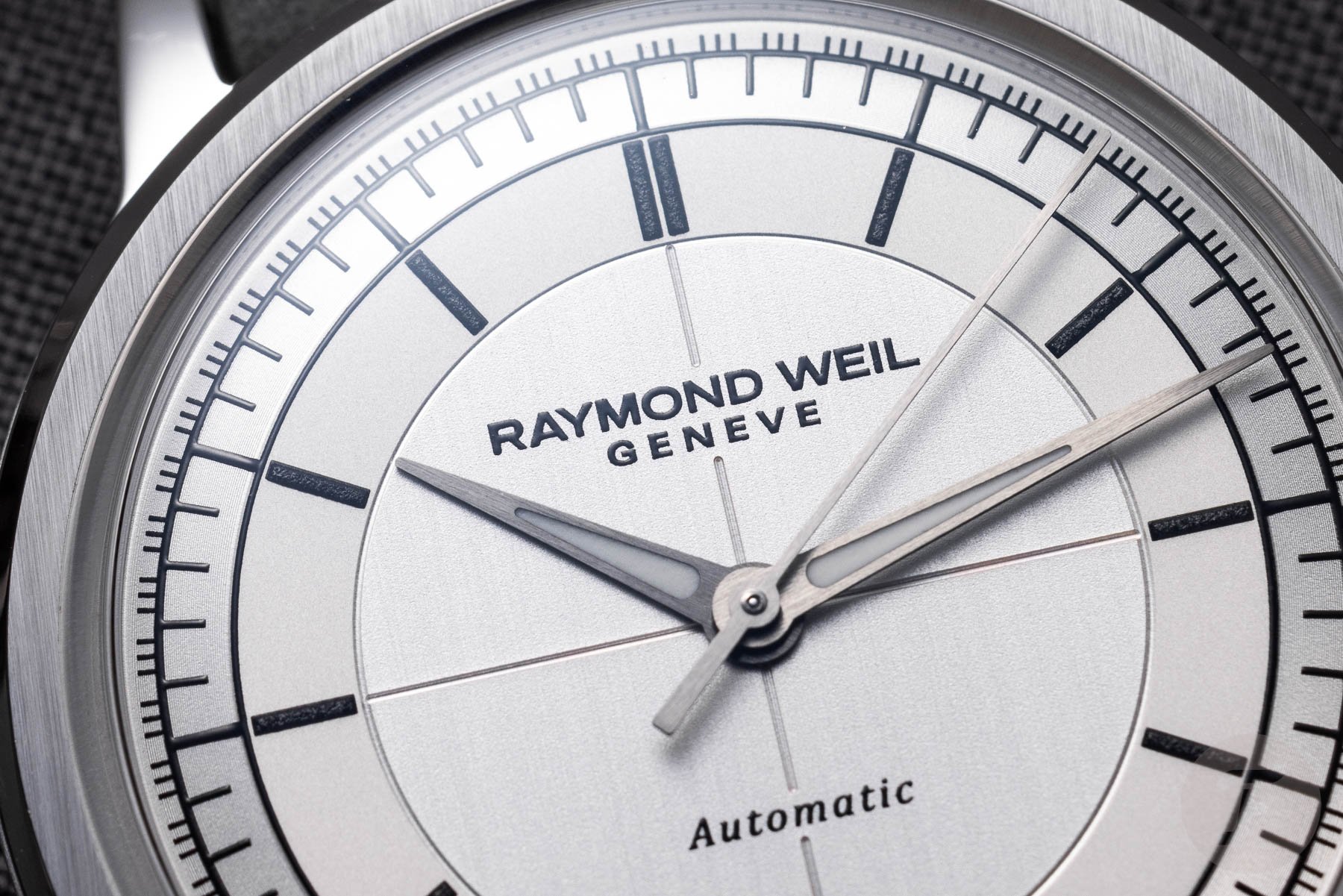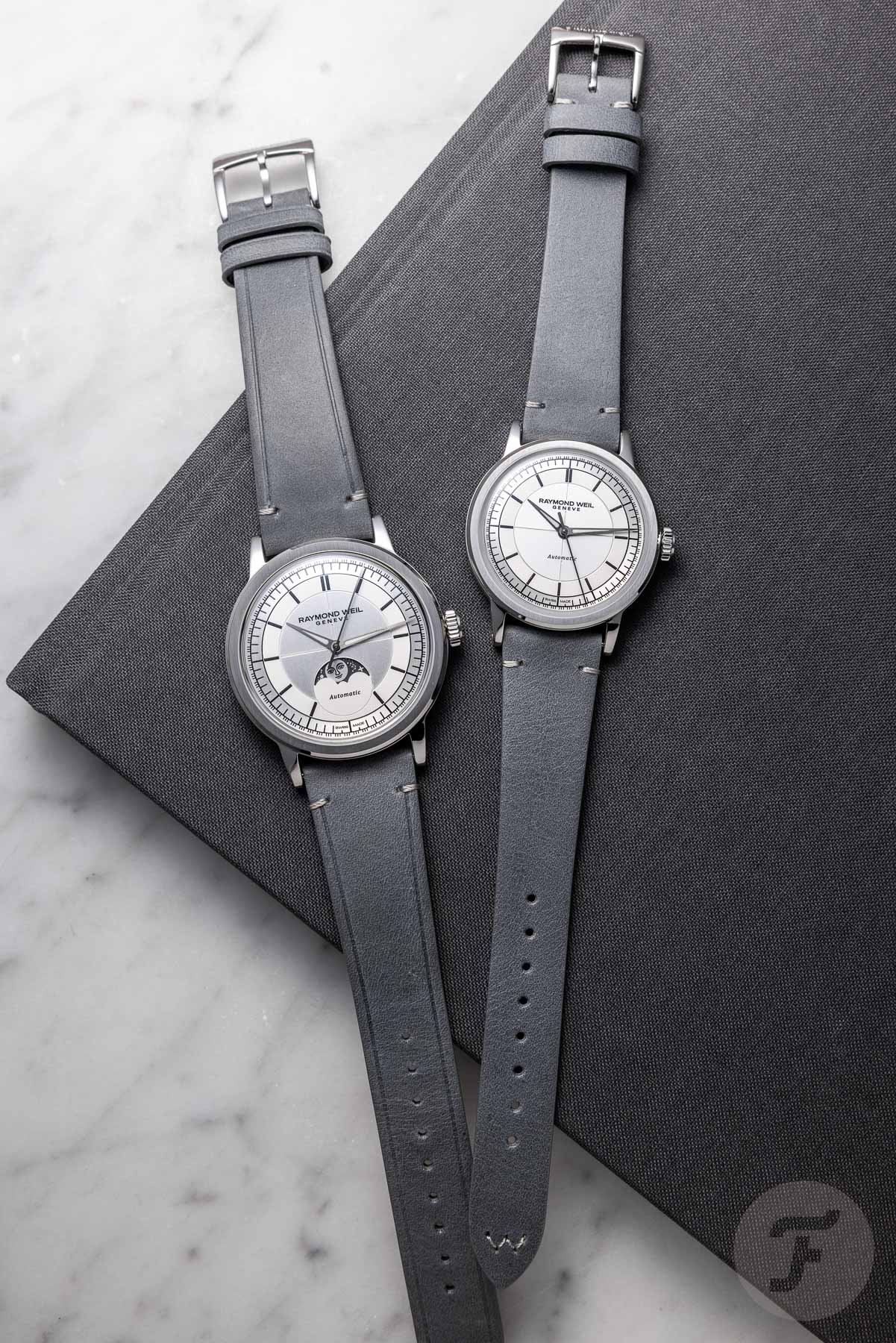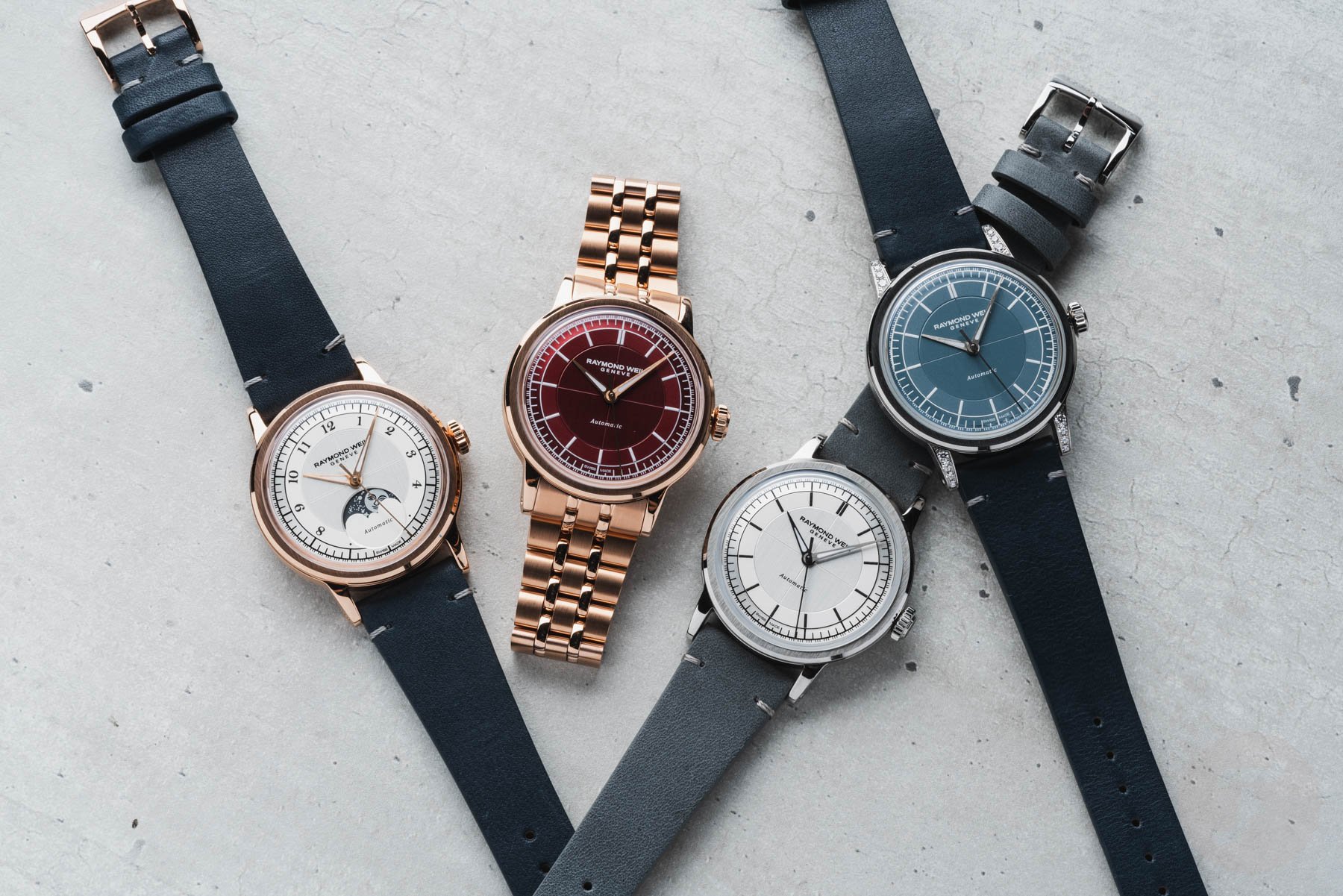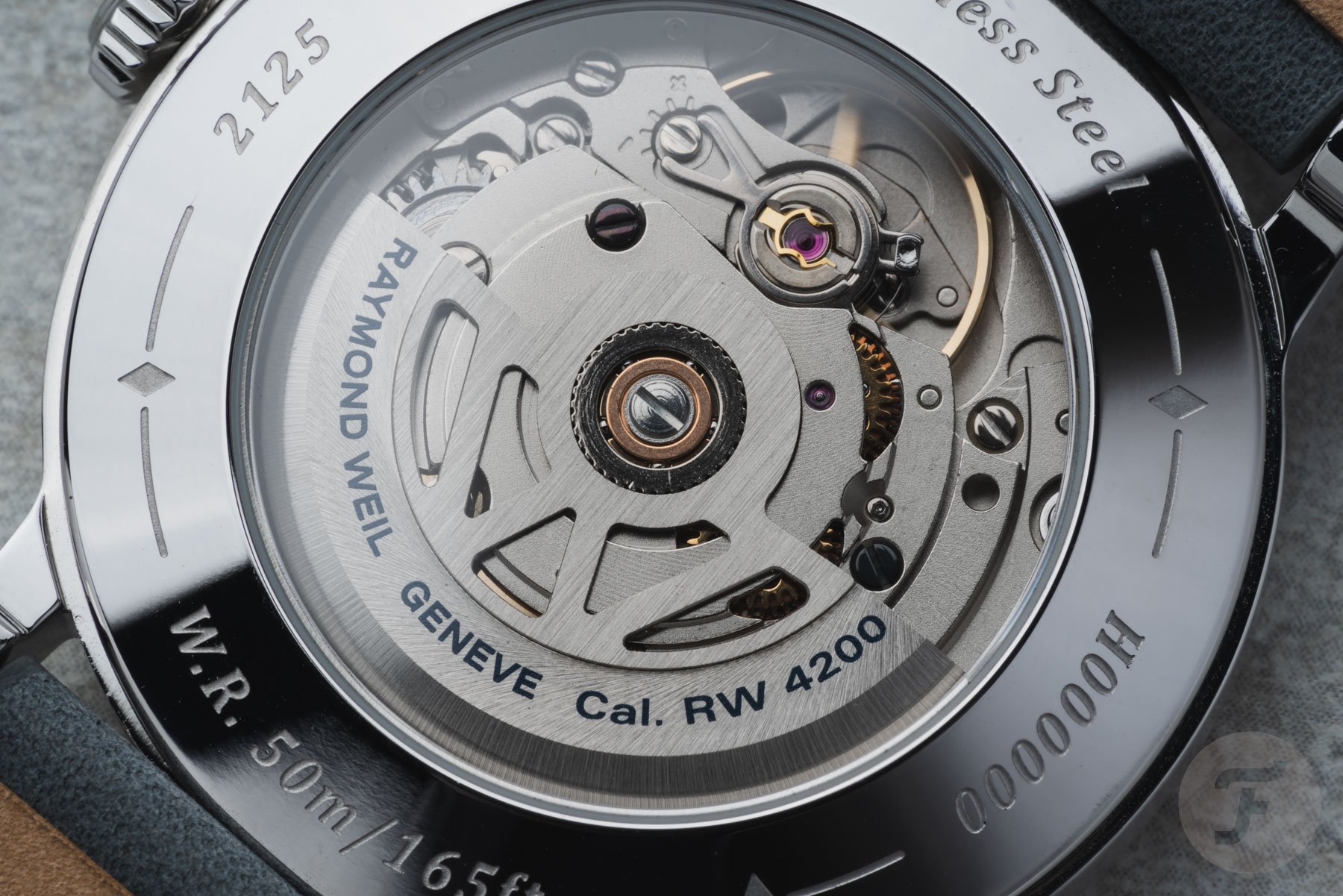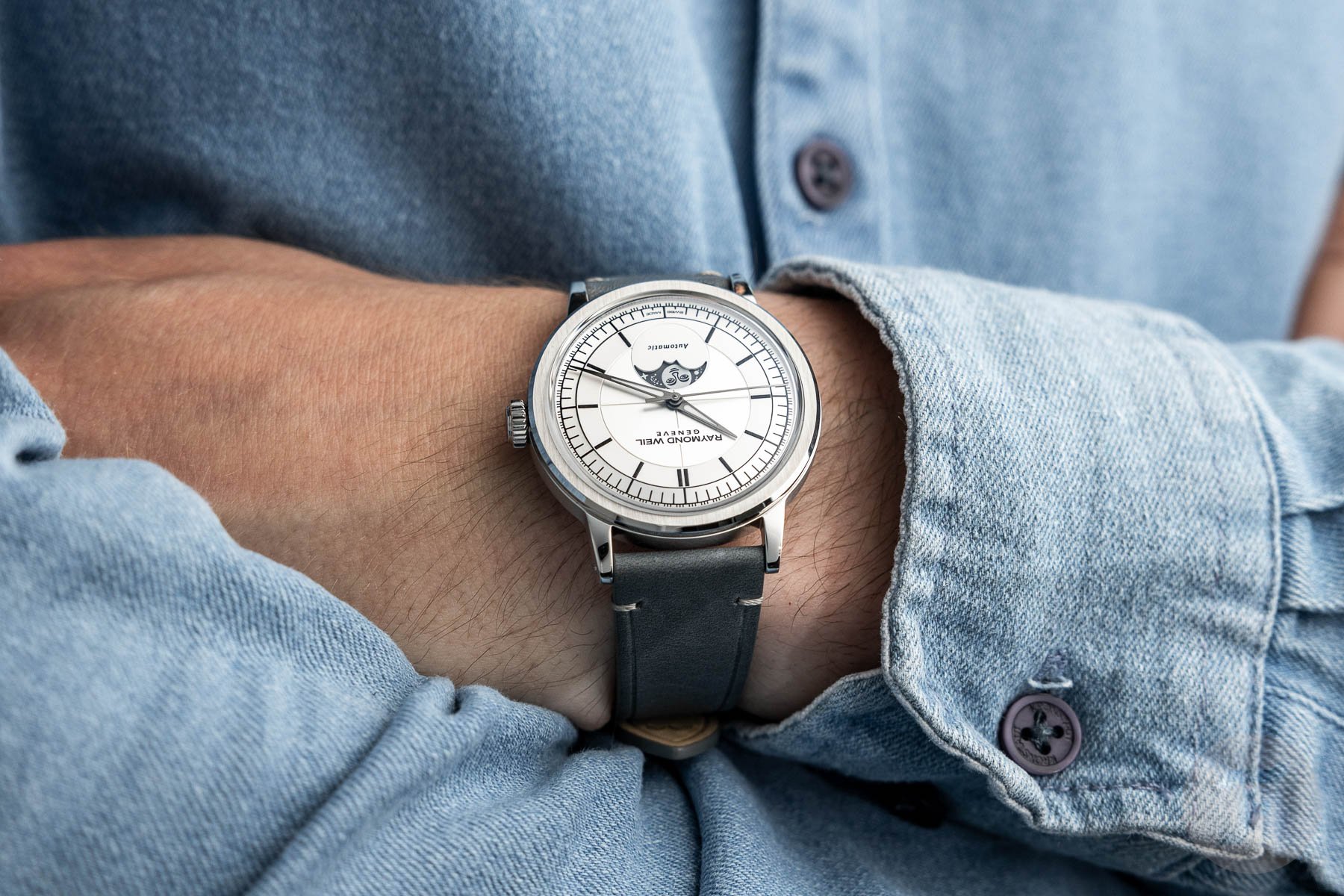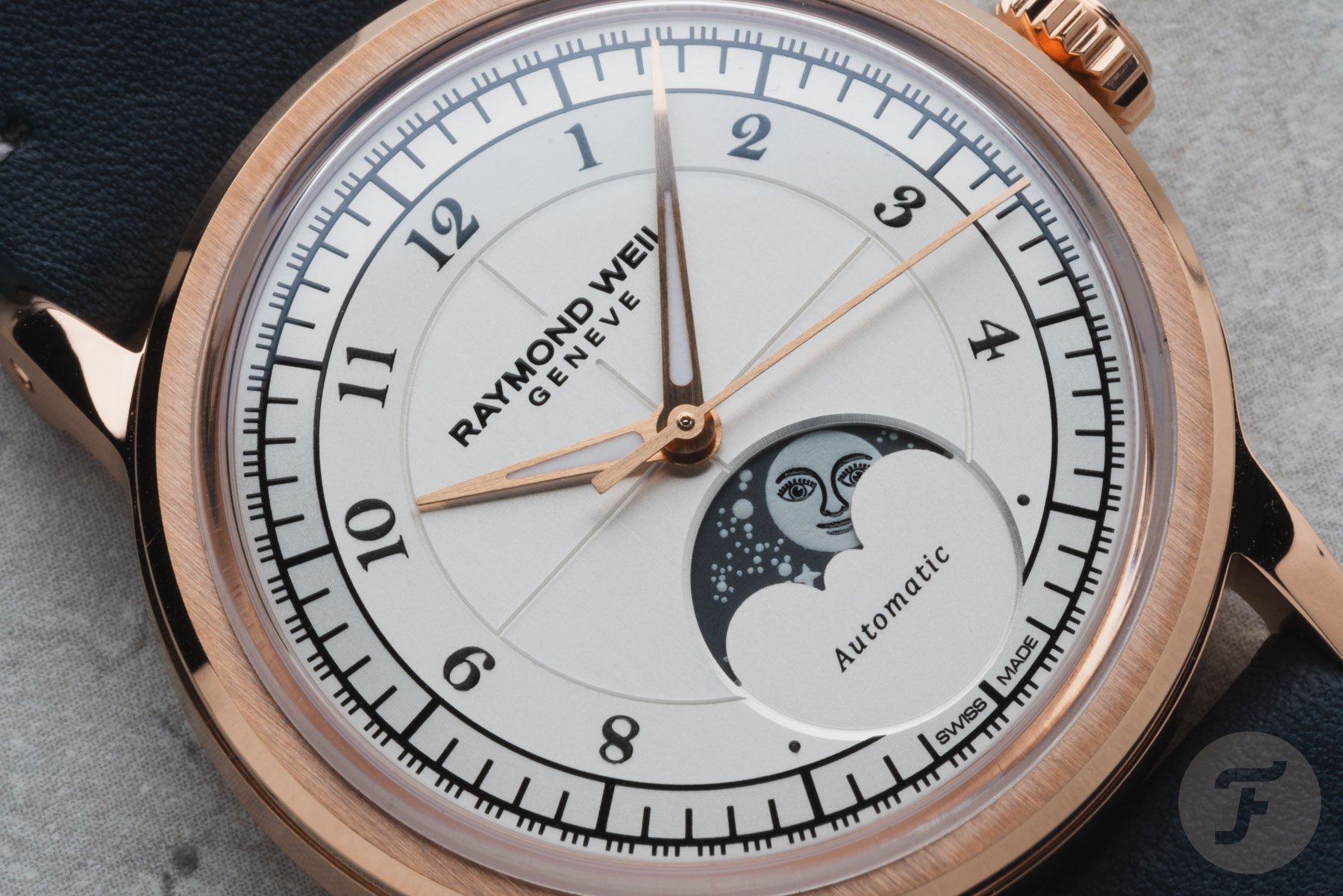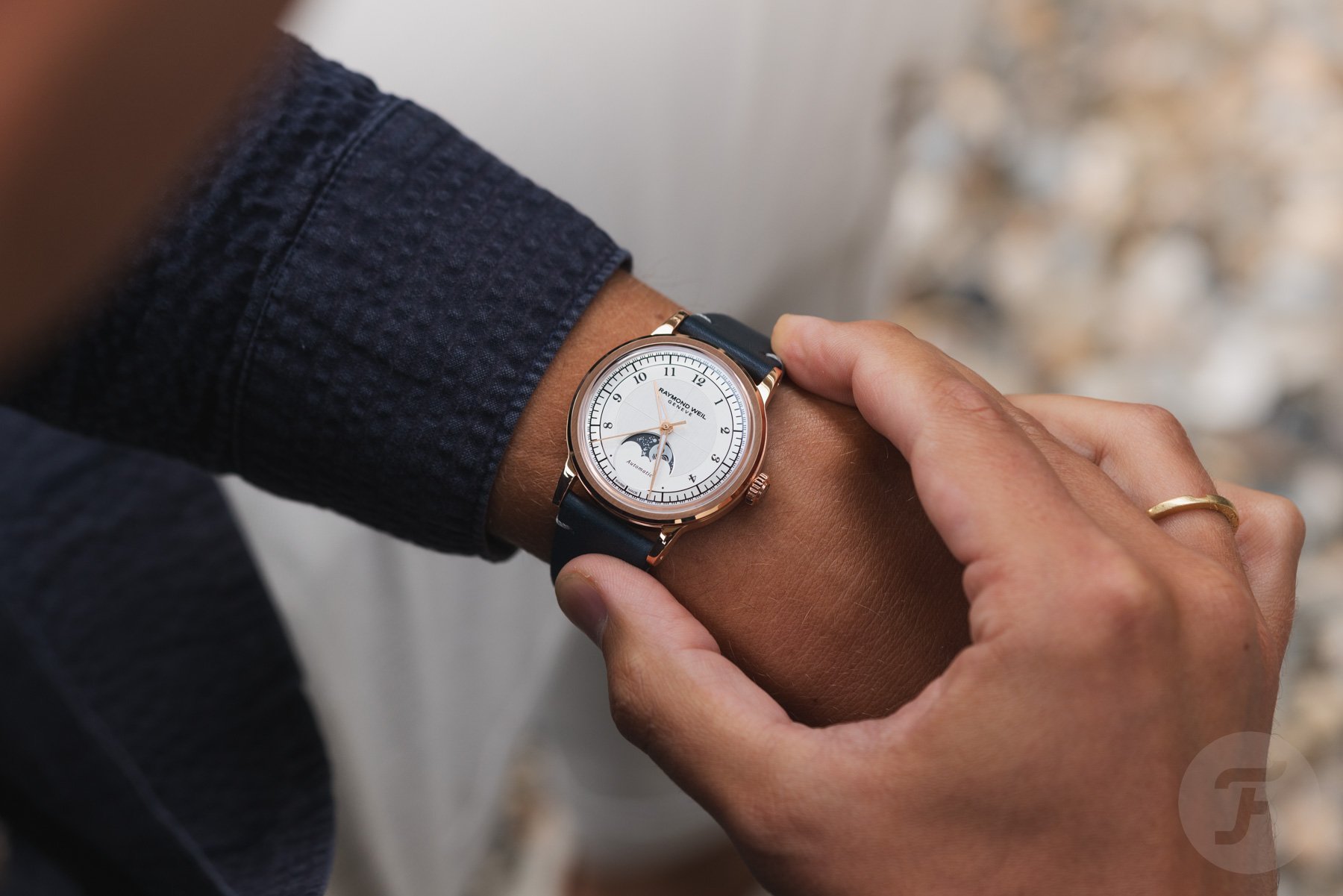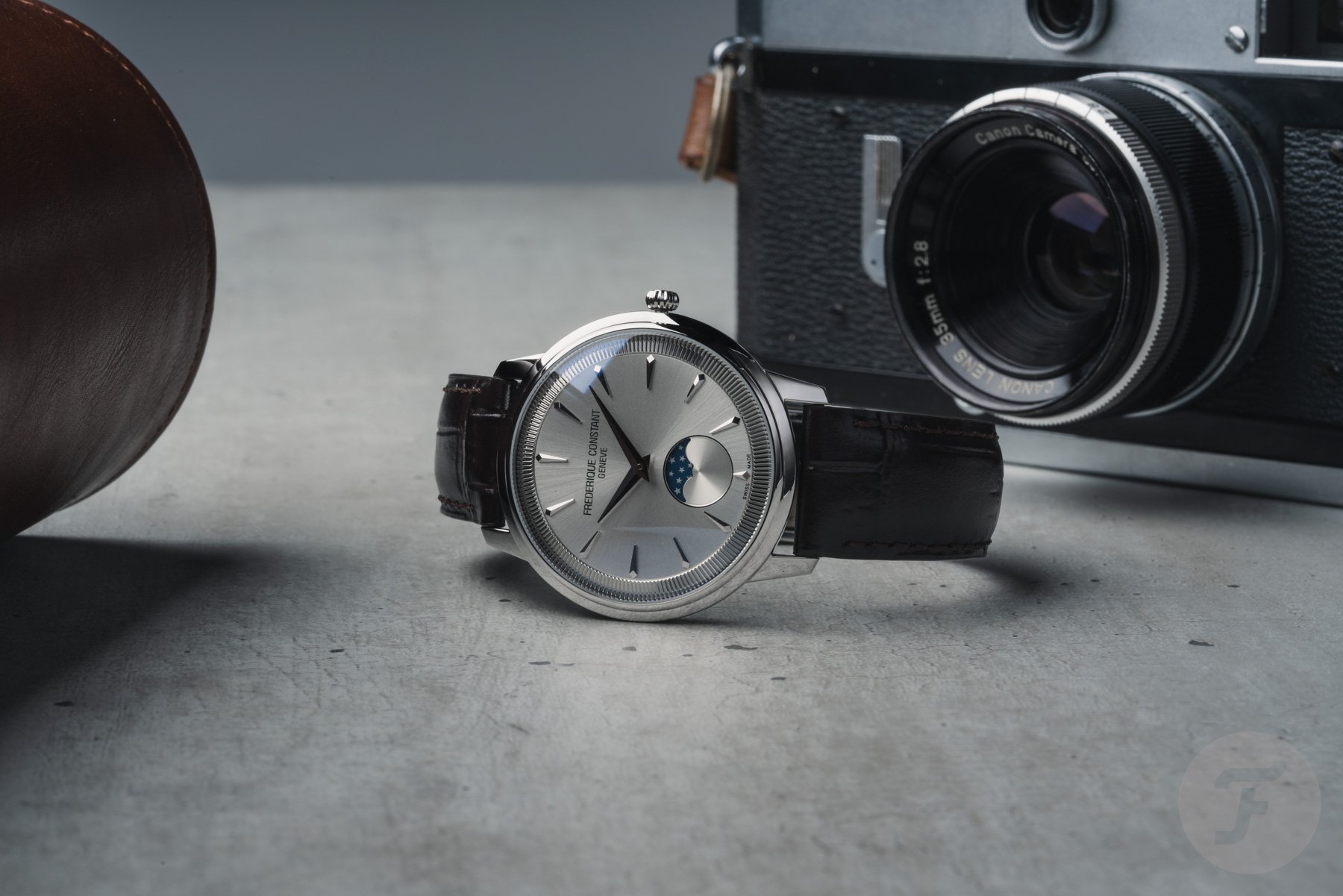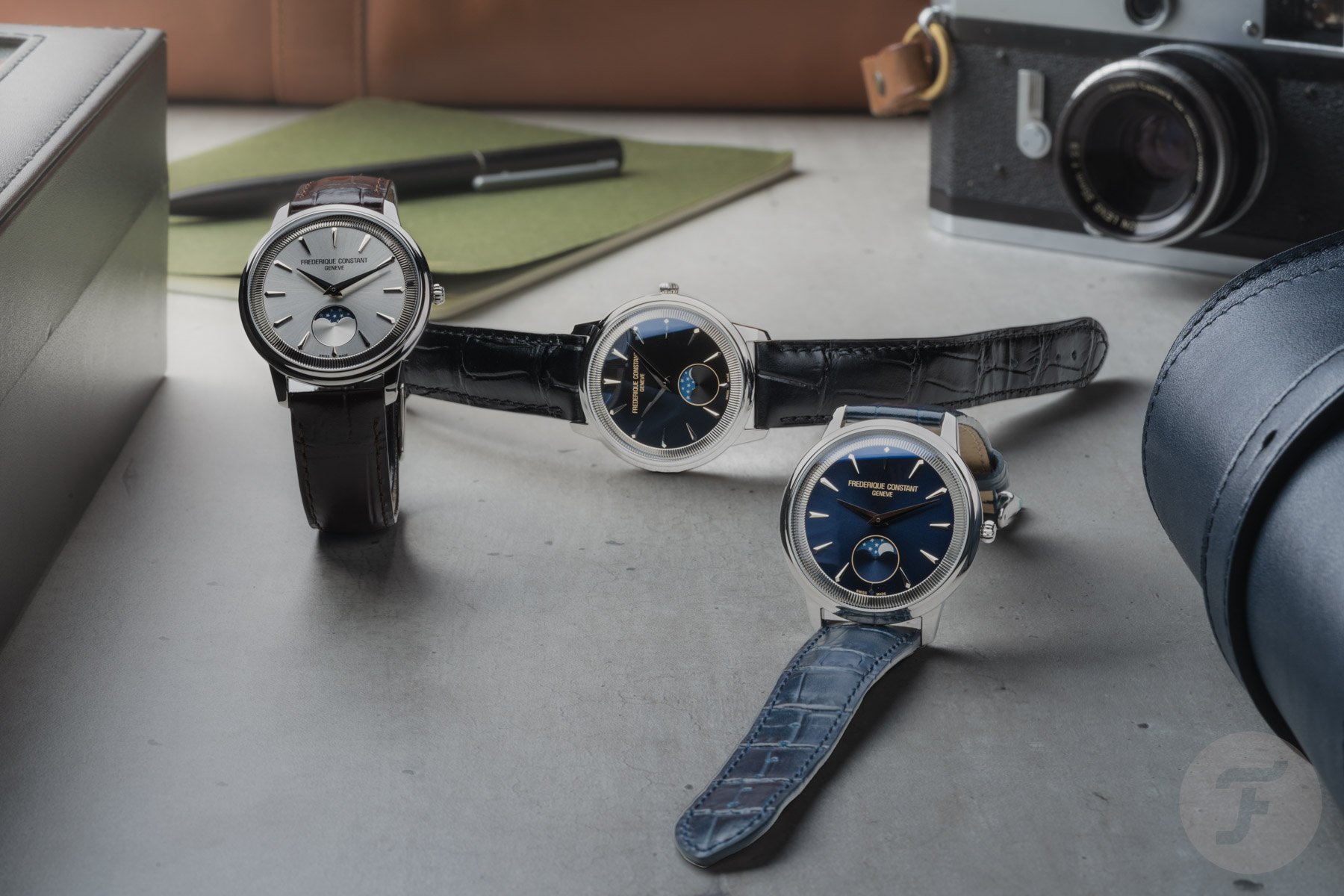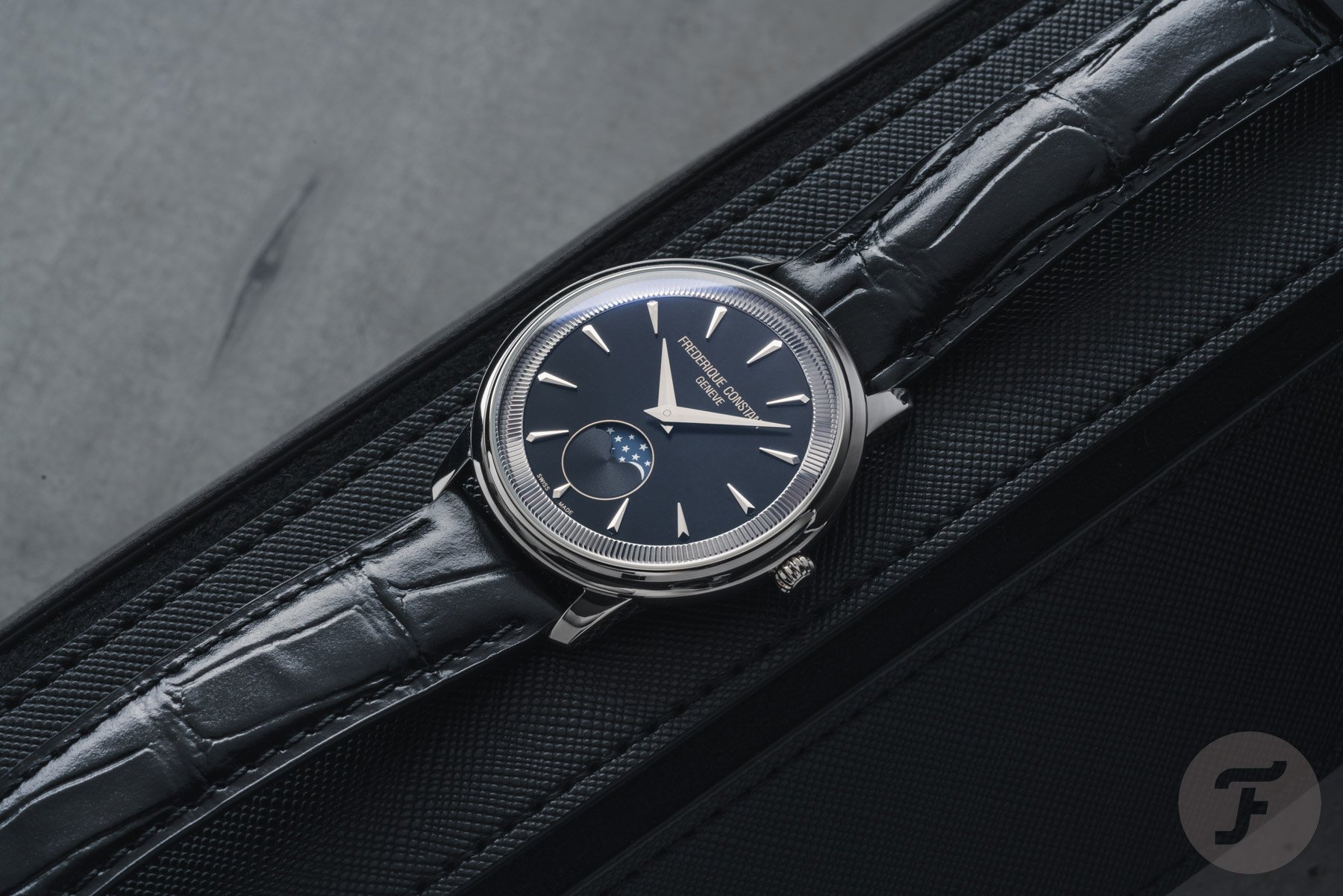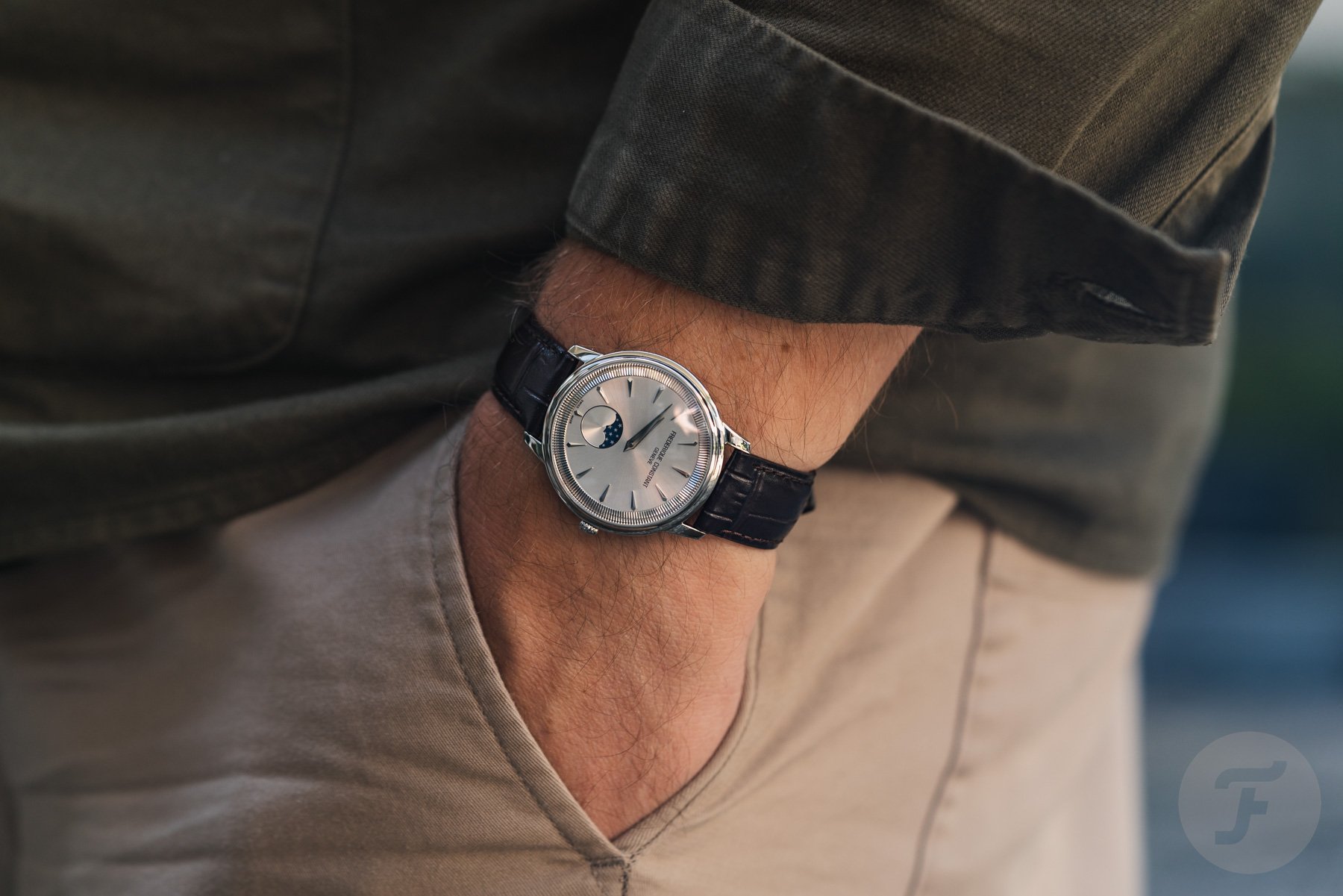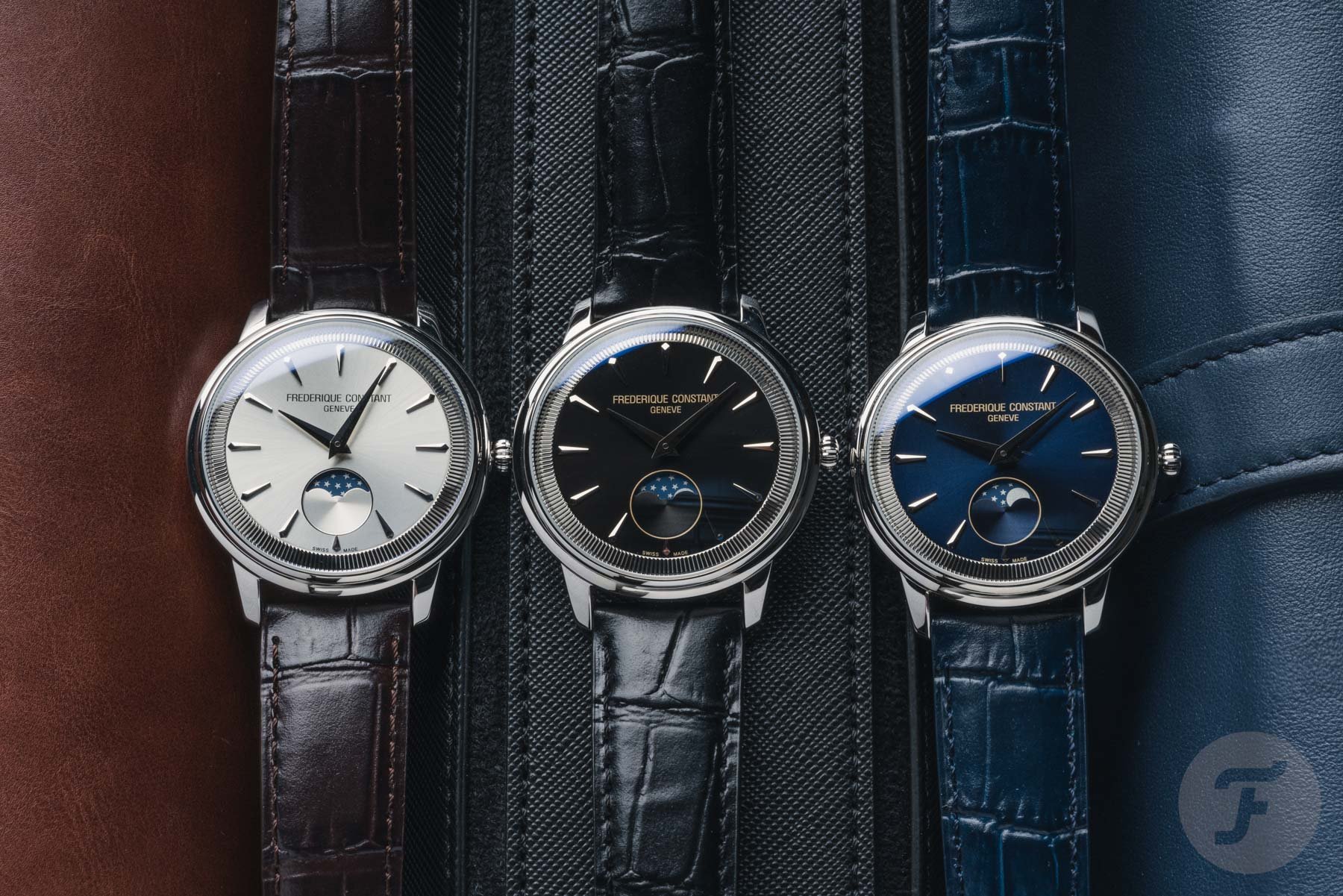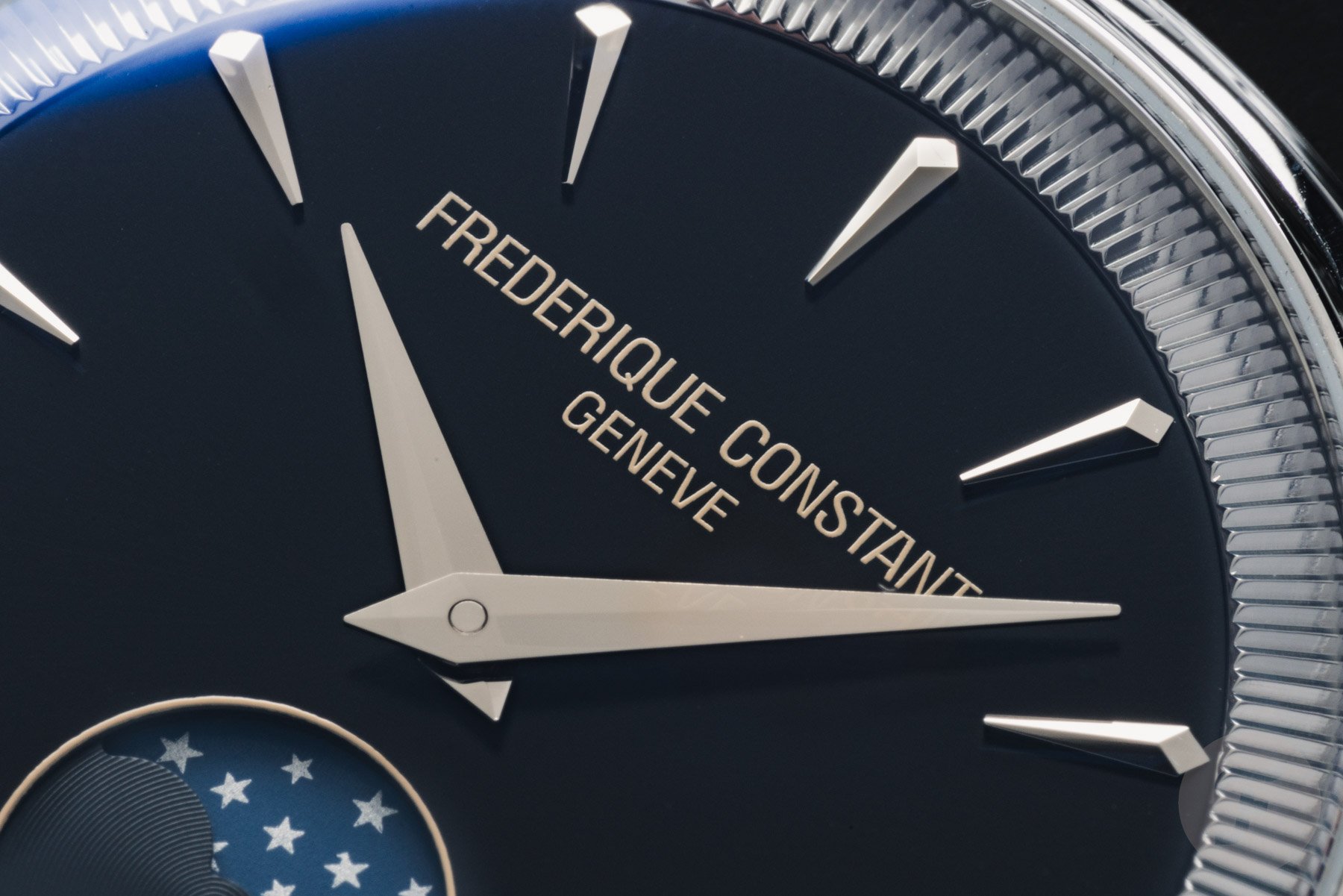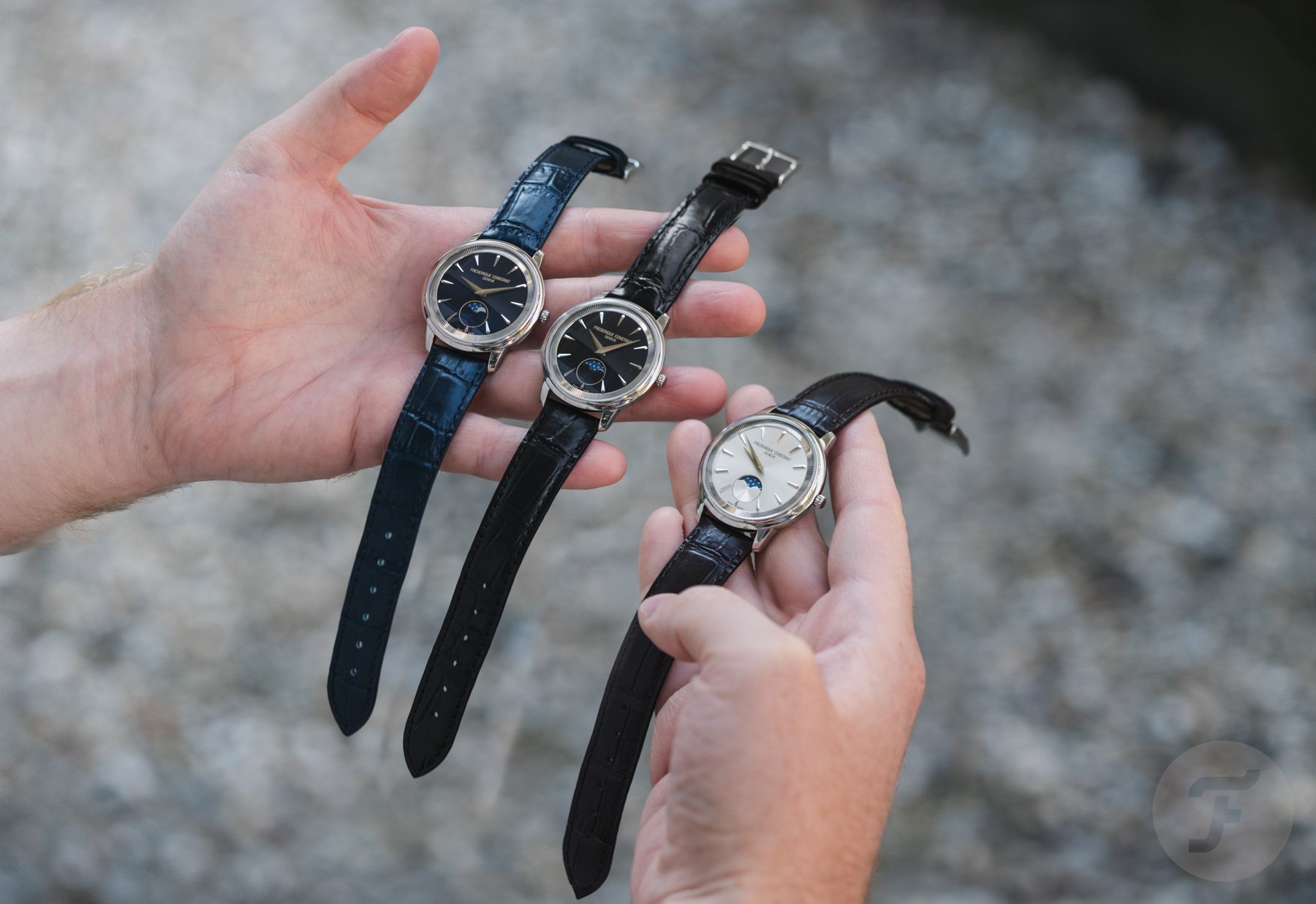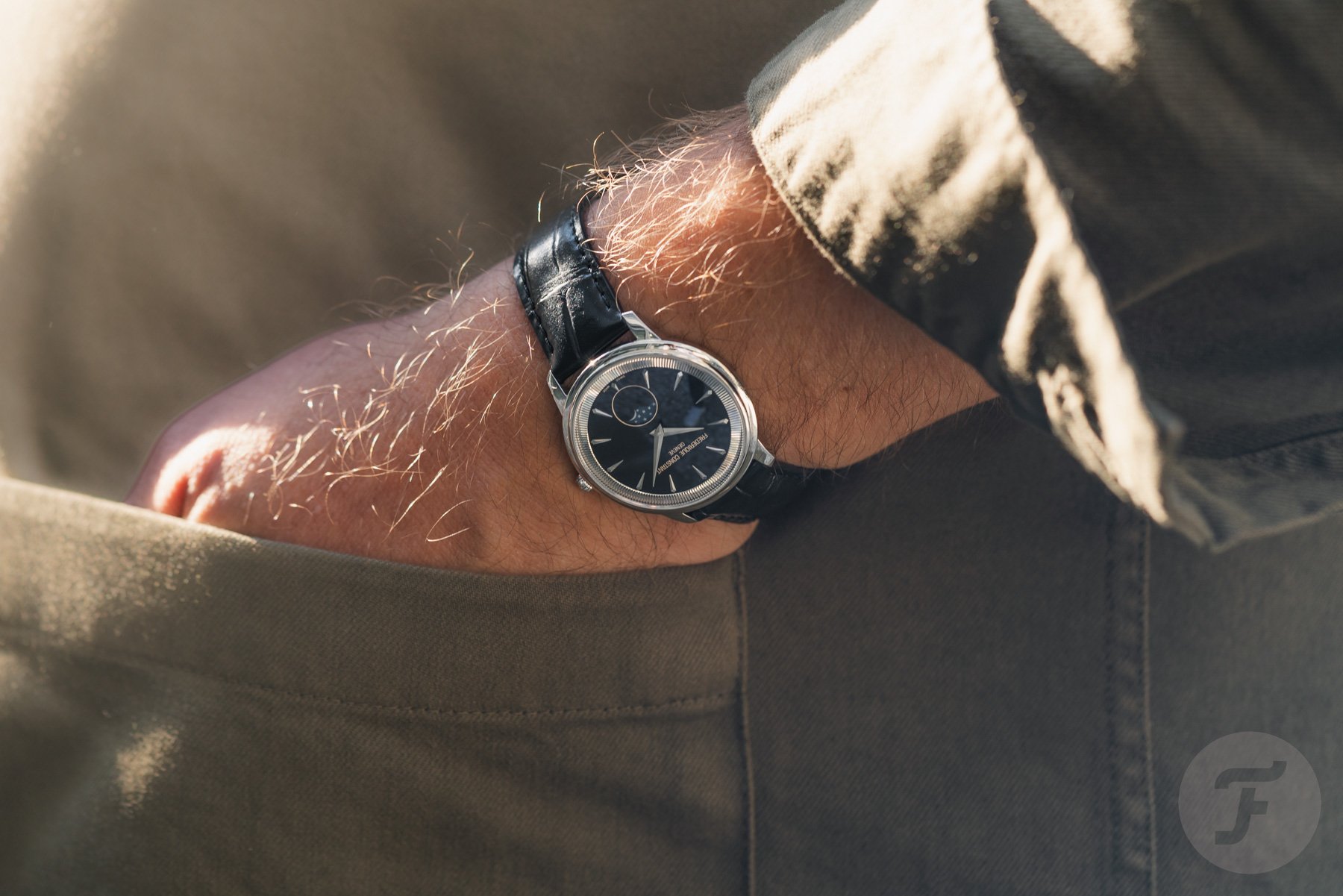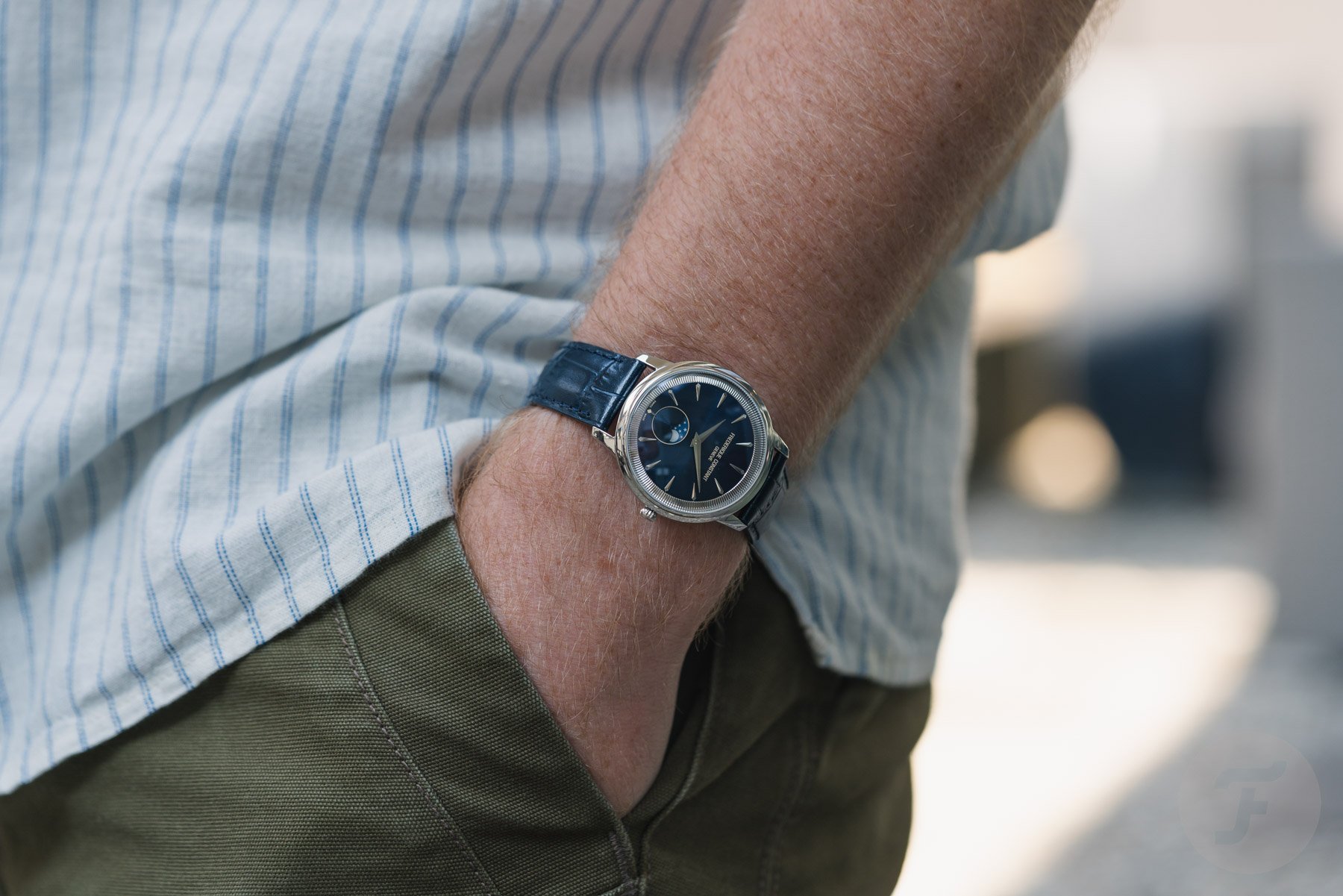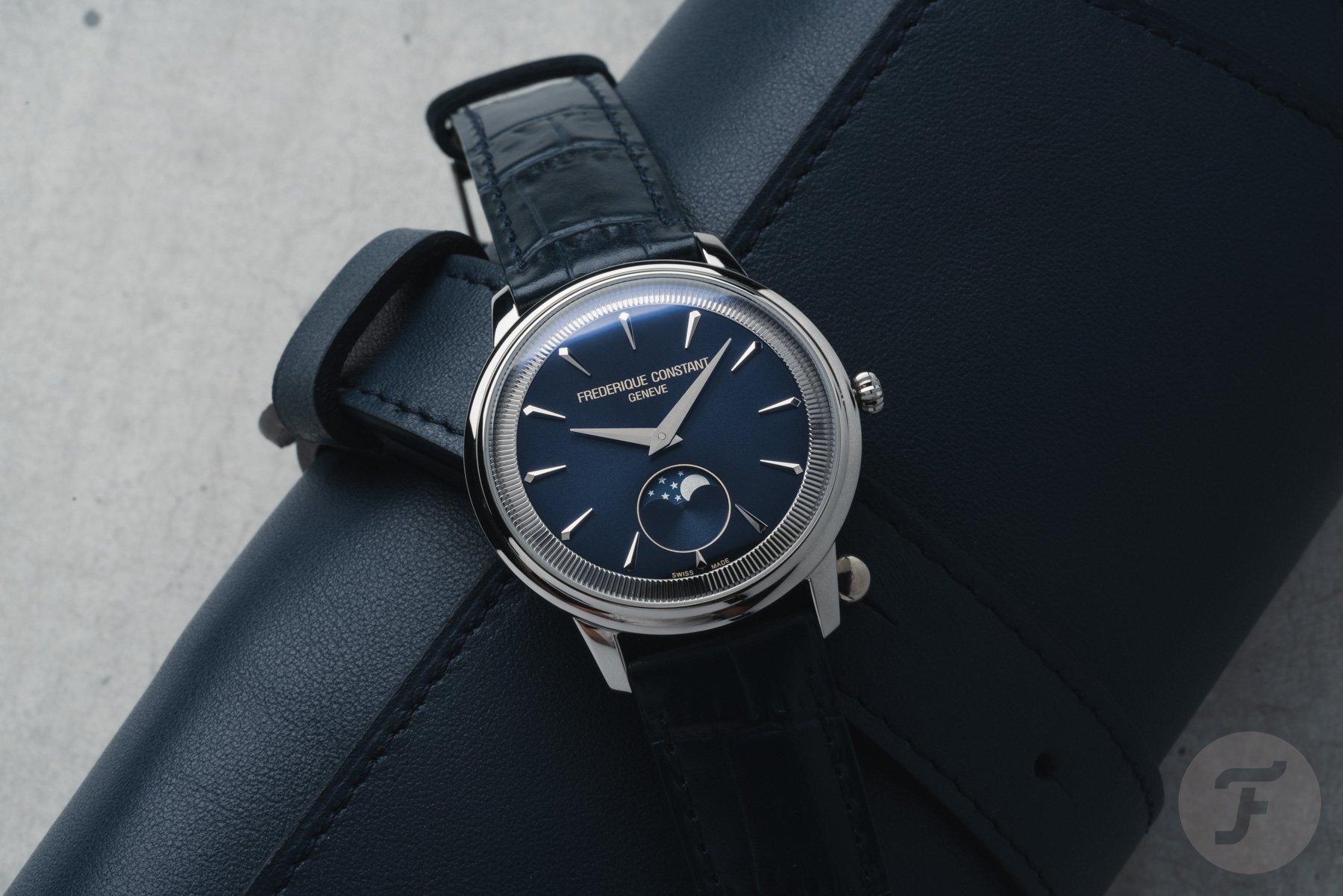Sunday Morning Showdown: Raymond Weil Millesime Vs. Frederique Constant Classics Moneta Moonphase
Last week’s Sunday Morning Showdown saw two very dressy watches pitted against each other. We continue the formal streak this week but in a much more wallet-friendly manner. These two dressy numbers were positively received here at Fratello, even if they don’t represent the ultimate in horology. The big question today is: if you want to buy a reasonably priced formal watch, do you go with Frederique Constant or Raymond Weil?
Don’t grab the pitchforks and start lamenting that these aren’t direct competitors just yet. We know, we know…different sizes, different prices, different kinds of movements, different everything — apples and oranges, right? Well, not exactly. If you own a collection of heavy-hitting sports watches and want one formal-leaning watch without spending Haute Horlogerie money, these should appear on your radar. But is the RW Millesime worth the jump in price from the FC Moneta?
But first, last week’s Sunday Morning Showdown
As always, we’ll kick things off with last week’s results. Daan and Michael took center stage with a modern Cartier Santos-Dumont versus a vintage Cartier Santos-Dumont. We half expected the results as you esteemed Fratelli tend to vote for modern watches. Still, it was interesting that the current model won with only 55% of the votes.
Granted, that is a comfortable win, but it still shows that the vintage Parisian piece of horological history speaks to many of us. Some commenters shared that the current model lacks “Cartierness” because it doesn’t look as chic as vintage ones. Others felt the vintage Santos-Dumont was either too dainty or not as neatly finished as the modern model. In any case, it was the current Santos-Dumont for the win!
Now, let’s move on to today’s showdown. Jorg will defend the Frederique Constant Classics Moneta Moonphase, while Thomas will represent the Raymond Weil Millesime. The first is a quartz time-and-moonphase dress watch with a price tag of €1,095. The second is an automatic watch in a few different sizes and versions, starting at €1,695. So, let’s start with Thomas telling you why you should splurge on the Millesime.
Thomas: Raymond Weil Millesime
The law of diminishing returns is clearly visible in the watch world. A €100,000 watch is unlikely to be twice as good as a €50,000 watch. You pay greater and greater premiums for ever-smaller increases in refinement. However, in today’s contenders’ price segment, doubling your outlay is often worthwhile. Today’s Sunday Morning Showdown is a clear example of how you get more than 1.5 times the watch at 1.5 times the price.
Usually, such differences show themselves in finishing and more sophisticated parts. This time, however, it is the very concept of the watch. I am not merely referring to the quartz versus automatic movements inside, although I will get into that in a moment. I am referring to the design first and foremost. We were all pleasantly surprised by the Moneta, but I fear it has some issues nonetheless.
It is rather derivative. Everything except its inner coin-edge bezel is lifted from historic watches from other brands. In this sense, it feels inauthentic to me. It is a Patek Calatrava homage with a battery, to put it very bluntly. The Millesime is a much, much stronger watch in this sense. Yes, it also leans on existing design elements, but it remixes them to something with a signature of its own. Yes, it is retro, but it is an original foundation on which Raymond Weil can build.
The Millesime makes the right compromises
Now, if you want a nice formal watch but don’t want to splurge on a JLC, Patek, or Lange, you are going to make some compromises. I feel that the Raymond Weil Millesime has its priorities straight in this sense. You do not compromise on character, as described above. The Moneta feels a bit underpowered with its Ronda quartz movement. That isn’t the right compromise in my book.
Hear me out, though, as I am no quartz snob by any means. I love quartz watches, and they can be the superior option. It just seems to me that in a watch like this, you don’t want a derivative design paired with a quartz caliber. That exudes “cheap alternative” and a general lack of confidence. Now the entire thing leans on the Moneta’s unique bezel, which is a bit of a gimmick if the rest of the watch is compromised.
The Millesime, on the other hand, gives you an affordable but capable automatic caliber paired with an original aesthetic. I love the Sellita SW200 series as they are some of the most tried and true, hard-wearing, and serviceable movements around. If you want the worry-free experience of quartz in an affordable mechanical watch, this is the one to pick. Again, the Millesime has its compromises hidden much better. You even get a sapphire window on the back to view the movement. Granted, it is no A. Lange & Söhne chronograph caliber aesthetically, but it is nice nonetheless.
The Millesime is much more versatile
You may have noticed I haven’t picked a specific reference within the Millesime lineup. There are two sizes to choose from — 35mm and 39.5mm — and some dial options. You can even get a moonphase complication, as on the Frederique Constant Classics Moneta. My points, however, apply to the entire Millesime line, so it makes no sense to decide for you which you would opt for.
Even if you pick just one, such as the silver time-only 35mm model on leather, it is much more versatile than the Moneta. The evolved sector-dial design is classical enough to make the Millesime your full-on dress watch. At the same time, it is sporty enough to serve as a true GADA watch. It goes with a T-shirt and jeans as well as it does with a three-piece suit. The same cannot be said for the Moneta, which does dressy only.
So, do I think the Millesime is better in every way? Well, no. The Moneta is better in terms of size, sitting right between the slightly too-small and slightly too-large RW offerings. There is also a case to be made for a quartz movement in a watch you will wear intermittently, especially if it omits the seconds hand. Anyway, let me leave it to Jorg to stress the FC’s strong points. Take it away, Jorg!
Jorg: Frederique Constant Classics Moneta Moonphase
Thanks, Thomas! I agree with you that the Raymond Weil Millesime is a very nice collection of watches, and I greatly appreciate it. As always with these match-ups, I look at the options based on what the same series offers. When it comes to the Millesime, there are plenty of good options to choose from. My absolute favorite out of all of them is the 39.5mm silver-dial Millesime Small Seconds. The moment that watch landed on Lex’s desk, I fell in love with it. Generally speaking, though, any Millesime Small Seconds model is a good option for me. The beautiful sector dials with the small seconds at 6 o’clock is a stunner.
But I’ll compare apples to apples and focus on the moonphase models. I understand that you present the entire Millesime collection as a good series of options, and in reality, our readers also have the right to choose. But for the sake of argument, it only makes sense to pick the two moonphase models. That’s where my focus shifts to the Frederique Constant Moneta, and the fact that there are better Millesime versions than the moonphase models is only one part of the argument.
A quartz watch with a complication?
So, what made me choose the Moneta Moonphase over the Millesime Moon Phase? As I stated in my review of the Moneta Moonphase watches, I did raise an eyebrow when they landed on my desk. Why would you choose a quartz dress watch with a complication? For most watch enthusiasts, including me, the magic is in mechanical complications. But after spending a bit of time with the watches, I found that Frederique Constant’s new series offers multiple reasons to prefer it over the Millesime.
First off, I am not a big dress-watch guy. There aren’t a lot of occasions for which I would need one, and most of them do not fit my style or daily attire. Because of that, I generally prefer watches like the Millesime Small Seconds, which does have a general everyday appeal. But for times when I would need a nice dress watch, I would be perfectly fine with an affordable option that I could pick up from the watch box and wear whenever necessary.
Looks that kill…the Millesime
And that’s where the Frederique Constant Classics Moneta Moonphase comes in. Both the practicality of a quartz-powered watch and the looks of this series make it a winner. Soon after raising that eyebrow when the watches landed on my desk, I grew to love the design. The modest 37mm stainless steel case has a 42mm lug-to-lug and a mere 6.75mm thickness, making for a super slim watch that easily slides under the cuff of a shirt, as a dress watch should.
But that’s not where it should remain all the time, and with every glance, the design started growing on me. The beautiful knurled inner bezel truly stands out. With just hour and minute hands, the Moneta lacks any ticking indication that would visually give away the quartz movement inside. On top of that, the coin-edge-inspired bezel also balances out the dial design quite nicely. All the elements are perfectly in sync, and the sharp dauphine hands fit the overall style nicely. It’s simply a super handsome watch in any of the three available dial variations.
Living in a retro-focused reality
And yes, you are right, Thomas. The Moneta Moonphase only “does dressy.” But I’d rather have a thoroughbred dress watch than a watch that does everything well to a limited degree. The Millesime Moon Phase is not a full-blooded dress watch, but it’s also not a proper GADA watch. So I would argue that its genre-straddling style is not its strength but its weakness. As for your remarks about originality, I recognize the sentiment that Frederique Constant is taking too much inspiration from traditional brands. This is a common argument that I have also used sometimes. But it was not something that bothered me at all with the Moneta Moonphase series.
In a watch world full of vintage-inspired designs, only a few escape the accusation of taking design elements from a slew of classics. In the end, though, it’s all about whether you can be happy with the watch on your wrist. And when it comes to the Frederique Constant Classics Moneta Moonphase, my answer is a wholehearted “yes.” Multiple Fratello team members also agreed on this. The design of the Moneta Moonphase fits a general dress-watch mold but is not hindered by mimicking something specific. It just looks very good, and the knurled inner bezel is a clever element that gives it character. On top of that, it features a stylish moonphase indicator at 6 o’clock rather than a moon with a little face on it. The latter is not the character I would look for, and it’s an element that would get on my nerves over time.
The price is right!
This brings me to my final argument — the price. I know you didn’t mention the €2,295 price of the Millesime Automatic Moon Phase, Thomas, because you described the entire Millesime collection. But I would love to quickly address this because, comparatively, the €1,095 price of the Moneta Moonphase is an important factor in choosing it. Whether it’s for someone who wears a dress watch sporadically and wants an affordable option, like me, or just someone who just likes to buy a watch every couple of years, the Moneta Moonphase is a stylish and practical option that doesn’t break the bank. The Millesime Automatic Moon Phase, on the other hand, is more than twice as expensive. That’s the final but crucial reason I would pick the Frederique Constant Classics Moneta Moonphase in this battle.
Voting time!
Now, it’s up to you, our readers, to vote! So, Fratelli, which do you prefer — the Raymond Weil Millesime (Moon Phase or not) or the Frederique Constant Classics Moneta Moonphase? Cast your vote, and share your motivations in the comments section below!

